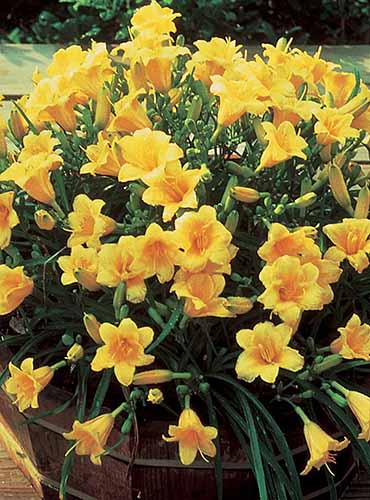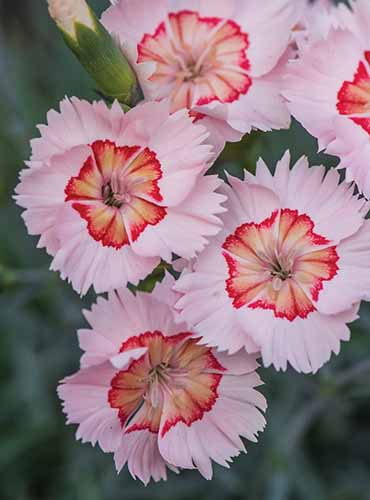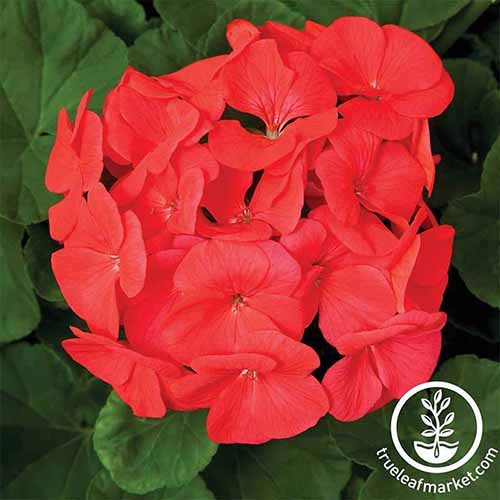Each blossom only lasts one day – hence the name – but each specimen will produce dozens per season, sometimes well over 200 per plant in ideal growing conditions.
‘Stella D’Oro’ is a petite variety that can be clustered together, forming masses of bright yellow, two-inch blooms on 10- to 12-inch stems above green scapes.


‘Stella D’Oro’ Daylily
‘Stella D’Oro’ bare roots are available from Burpee.
Most varieties bloom from spring to fall and will eventually need to be divided as they spread. They range in height from about 12 inches to well over four feet, with an 18- to 24-inch spread.
Full sun is best for daylilies, except for darker-colored cultivars that need protection from harsh afternoon sun.
Learn how to plant, grow, and care for daylilies.
10. Dianthus
The Dianthus genus contains over 300 species, including D. caryophyllus, commonly referred to as carnations, and sweet williams or D. barbatus – both of which are common choices for mass planting.
While sweet williams and pinks are mass-forming plants with blooms that form on shorter stems, carnations can grow up to two feet tall, depending on the variety.


Most are perennials that retain a tuft of evergreen, grassy foliage in mild regions; however, both annual and perennial types readily self-seed.
Their gorgeous colors and often fancy, showy blooms will grace the landscape between spring and fall.
If you need a compact flower for mass planting, Dianthus is an excellent choice in Zones 3 to 9. Check to make sure the species you select is suited for your regional conditions.
For a monotone shock of fuchsia to purple, perennial maiden pinks (D. deltoides) can be spaced about four inches apart, along a walkway or in an open area where they’ll form a carpet of color.


‘Georgie Peach Pie’
Dianthus ‘Georgie Peach Pie’ plants are available from Burpee.
These 10 to 12 inch plants produce profusions of white blooms with peachy-pink centers, separated by a fuchsia band.
They also have a clove-like scent that adds to their appeal en masse.
Allow about six to 12 inches in between for larger dianthus plants such as carnations, depending on which variety you choose.
Learn more about how to grow dianthus in our guide.
11. Geraniums
There are a few different types of geraniums that are well suited for this style of planting.
The various species are often described as hardy or garden varieties such as cranesbills and pelargoniums, ivy types, and scented types.


Cranesbill geraniums are hardy perennials that return each year with simple, single blossoms in jewel tones of blue, lavender and pink.
They’re an excellent choice for mass planting as they are low maintenance and have a rhizomatous spreading habit.
Pelargonium flowers have two upper petals that differ from their three lower petals and are often showier than cranesbills.
They’re available in a wide range of tones such as deep red, bright fuchsia, salmon, and dark purple.
Pelargoniums are less hardy than cranesbills, usually considered annuals in most regions where winter temperatures fall below about 30°F.
Learn more about differentiating between cranesbills and pelargoniums in our complete guide to growing scented geraniums.
While geraniums do add beauty, color, and texture, they’re not particularly appealing to pollinators.
In a bed or border, garden geraniums (Pelargonium x hortorum) are a pretty choice.
They are available in single colors and variations that include striping and double blossoms, all of which have equally striking foliage.
Most species and cultivars are mound-forming, prefer full sun, and soil that drains well.


Pinto Premium Series
You can find Pelargonium x hortorum seeds from the Pinto Premium series in packages of 100 at True Leaf Market in various colors including coral, rose, salmon, lavender, and white.
This series is known for its stunning four- to five-inch-wide flower clusters and attractive banded foliage, and for its drought and heat tolerance.
Plants reach 18 inches at their tallest, and have a spread of about 12 inches.
These are annuals in all regions north of Zone 10. The rhizomes can be dug up and stored through the winter and replanted in the spring.
Learn more about how to grow garden geraniums in our guide.
12. Grape Hyacinths
It’s important to note that, in some settings, grape hyacinths can become invasive.
However, if you have an expansive area to fill in and need a low-height, virtually maintenance-free perennial to add a spreading field of color, Muscari is a good choice.
The purple springtime blooms resemble clusters of grapes and the grass-like foliage provides contrast.


Not only do Muscari plants self-seed, but they also spread by forming offshoots or bulblets.
While grape hyacinths prefer full sun, if you’d rather they don’t overtake a major portion of your lawn, you may prefer to place them in partial shade.
Most species in the Muscari genus grow best in Zones 3 to 9, and some of the larger types are extremely cold hardy.
Learn more about grape hyacinths for mass and border plantings here.
Bear in mind that they don’t offer much scent and don’t appeal greatly to pollinators.
The indigo-blue M. armeniacum are the most common, and they do make a striking presentation, but there are other colors and forms available as well.


Purple Grape Hyacinth
Bulbs are available in quantities of 25, 50, and 100 from Eden Brothers.
Most varieties only reach about eight inches in height max, and the grassy foliage typically spreads to about the same width, although the foliage dies back while they are still in bloom.
Learn more about growing grape hyacinths here.
13. Impatiens
Also known as busy lizzies thanks to their spreading tendencies, members of the Impatiens genus are very diverse in form, but I. walleriana is the most commonly chosen species for bedding plantings.
This species grows in a dense, rounded mound, producing blooms throughout the spring and summer.


Deadheading regularly can help to keep them blooming – sometimes for as long as 200 days in a season!
Available colors truly run the gamut, ranging from bright white to peach, purple to deep red, some with candy striping or contrasting center tones.
They’re also available in single or double blooms.
While I. walleriana prefers partial shade, especially in high temperatures, some cultivars have been bred for better sun and heat tolerance.
The Beacon Mix features coral, pink, and white flowers.


Beacon Mix Impatiens
You can find packets of Beacon Mix seeds available at Eden Brothers.
Impatiens are annuals in Zones 2 through 8, and perennial in Zones 9 to 11 that prefer moist, well-drained soil.
Note that they’re not particularly drought-tolerant and they’re also not a pollinator favorite as they produce little to no nectar.
Plants can range in height from six inches to well over two feet in height, so spacing will depend on which type you choose.
Learn more about how to grow impatiens.
14. Marigolds
Out of all of the species on this list, marigolds are likely the easiest to grow.
When I was a kid, my family would gather marigold seeds and save them in a coffee can for the next year – and that is the entirety of the maintenance we performed.
Marigolds belong to the Tagetes genus, which contains over 50 species.
Most marigolds are bright yellow or orange annuals, although there are some perennial types, such as T. lucida, also known as Mexican tarragon.


Most varieties self-seed, or seed can be collected for an inexpensive to free option for planting in consecutive years.
Though they’re very tolerant of less than ideal growing conditions, aim to provide full sun and good drainage.

